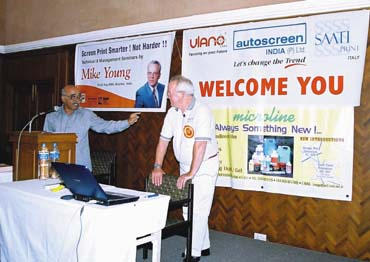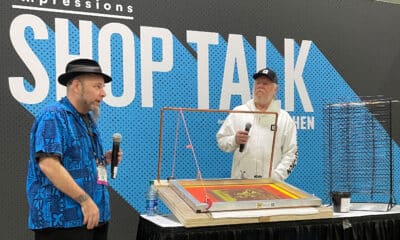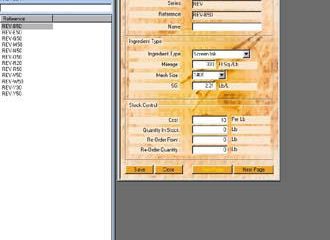Destination India
Published
19 years agoon

It was a real blessing when, after a long and sleepless flight from New York, the aircraft door swung open during the early hours of a very warm and very humid morning toward the end of last year’s Monsoon season in India.
It was a real blessing when, after a long and sleepless flight from New York, the aircraft door swung open during the early hours of a very warm and very humid morning toward the end of last year’s Monsoon season in India. Greatly looking forward to a comfortable bed in a nice, air-conditioned hotel room, I first had to wrestle with an army of persistent porters all vying for my luggage with continuous cries of "Taxi sir, taxi sir, taxi sir!" Once I clumsily found my way out of the terminal, I was suddenly, but cheerfully, greeted with colorful garlands from Devang Sheth, the publisher of Screen Print India magazine and my host for India’s Screen Print 2004 exhibition. An excited delegation of officers from the Screen Printing Association of India (SPAI) was also hand. This was my initial welcome to Mumbai (formerly known as Bombay), the captivating commercial hub of India–a place that can be both fascinating and infuriating. It is home to a diverse population, some 18 official languages, and sometimes boisterous and undisciplined traffic. It’s also a hotbed of prosperous, high-tech industries. This city, sprawling over a landscape of small islands and man-made earthworks, would be my temporary home in the world of screen printing for the next few weeks. Facts and figures India is an enormous country, so getting hard statistics about the screen-printing industry is a challenge. However, I did find some numbers while I was there that may help describe the market. I must emphasize, however, that these figures are approximations and should be used only as a loose guide–reliable numbers simply do not exist, and estimations vary depending on whom you ask. India is home to about 25,000 full-time screen-printing businesses, and possibly only 10% of those are considered major players. Meanwhile, more than 40,000 companies have been mentioned as part-time screen-printing companies. My estimate is that there are about 150 main–and usually very large–industrial screen-printing operations and between 7000-10,000 textile shops of all stripes. Most companies are staffed by only three or four people who work an average of 25 days a month in eight-hour shifts. As many as 1 million people may be earning a living from screen printing in India. Approximately 1500-1800 companies of all types are believed to supply the industry with goods ranging from squeegees to large-format multicolor printers. Around 30 large industry suppliers dominate their respective fields and serve the market nationwide. The value in terms of goods produced by Indian screen-printing market has never been professionally assessed or projected to anyone’s knowledge, and I am not going to start now. But growth is considered to be very bright and bullish, and most predict the annual growth rate of the industry to be 10-15%. India produces some of the finest screen-printed products anywhere, including textiles, commercial graphics, electronics, and various industrial goods. The exhibition India’s sixth biannual screen-printing exhibition was held over the course of three days at Mumbai’s Nehru Center during the latter half of August 2004. This show was the official reason for my presence in India, as I was to conduct a series of technical seminars during the exhibition on varying aspects of screen printing (Figure 1). The exhibition attracted some 7500 visitors, several of whom came from neighboring countries and beyond. I met attendees who thought nothing of spending 24 hours or more on train just to come to the expo. Ninety exhibitors showed their wares, and high traffic forced many to move their negotiations and deal-making discussions with customers into the aisles. As expected, every type of product, equipment, and service imaginable was on exhibit. An Open Forum session was also held that allowed visitors to ask questions and hear industry experts tackle any problem thrown at them. It proved to be so popular that people who could not make it to the show actually e-mailed their questions in. The list of questions grew to number more than 150! Aditya Exposition–the exhibition organizers–held a printing competition, known as Screen Print India Awards 2004 (Figure 2). While the competition was smaller than the Specialty Graphic Imaging Association’s (SGIA’s) Golden Image awards in the US, it was unquestionably large on enthusiasm, with more than 900 pieces entered. What made these prints a little special, at least for me, was to realize the remarkable circumstances under which many of them were produced. The printers who created them lacked a full range of support services from suppliers and environmental comforts we have grown used to and take for granted in the United States and Europe. Despite these limitations, it seemed that Indian printers went out of their way to eagerly show and discuss the fruits of their labor. Their works demonstrated an obvious desire to reach ever higher levels of proficiency in screen printing. It was clear to me that visitors were extremely interested in obtaining greater information, support, newer products, and process knowledge in order to be on the same footing as their counterparts across North America and Europe. In the short space of two days, I already determined that they had the proper mindset to achieve the very best quality and efficiency possible, even considering the circumstances under which they routinely work. The struggles Unlike other places I visit, I never once heard price or cost being factors in the Indian pursuit of more business. Whatever the subject matter under discussion, talk inescapably always came back to quality and how it could be improved upon. This commitment to quality is evident in the very high number of Indian printing companies that are ISO certified. As alluded to earlier, the Indian screen-printing community does not enjoy the same level of support from their suppliers as customarily found in other countries. It’s not that suppliers and distributors are bad, lazy, or anything like that–on the contrary. The marketplace, together with its economically weaker structure in terms of industry, is quite a bit different than those of similar market segments in developed countries. While a few major suppliers offer extensive support, most regional suppliers and localized distributors simply can’t afford to invest in such services to attract and keep customers in this marketplace. The tour Before first light on the morning following the exhibition and seminars, I hit the road for the less humid inland city of Puné, a gigantic manufacturing center about 125 miles (200 km) east of Mumbai. Puné is home to one of the most sophisticated screen-printing communities in the country, in terms of upscale commercial/industrial printers and suppliers. One such company is Puné Metagraph, a screen-printing business that I had the opportunity to visit (Figure 3). As might be inferred from the company name, Puné Metagraph started out printing, stamping, and diecutting various types of metal nameplates for domestic OEMs. Over the years, their core business expanded to include additional product lines, such as self-adhesive OEM labels, logos, auto decals (a huge business in India, literally worth millions), signage, in-mold decorating, and doming. Puné Metagraph is certified ISO 9002, as well as ISO/TS 16949:2002, principally for greater process discipline and reliability in their respective marketplace. Premium graphics After three days experiencing what it feels like to work in a highly certified auto decal/OEM labeling environment, I retraced my steps back to Mumbai, this time for a two-day visit with Spectrum Scan, a commercial/graphic-art screen printer (Figure 4). This company specializes in process-color printing and P-O-P displays. With a staff of 110 people, Spectrum Scan has two separate working businesses: 45 personnel in prepress and the rest in screen printing and display fabrication. The prepress part of the operation is housed in an old area of the city with the corporate office located in another part of the same building. To achieve the required cleanliness in prepress, Spectrum Scan gutted out everything and rebuilt the facility’s interior from scratch. The contrast between the rustic, old, worn-down-looking exterior and the bright, modern interior one plunges into upon entering the building is quite surprising. Spectrum Scan is climatically controlled, of course, and has an armada of top-of-the-line desktop Macs to handle every imaginable piece of graphic-design software under the sun. The operation is also supported by a fleet of the latest technology in scanners of all types and sizes, imagesetters, and small- to large-format digital printers–all merrily churning away non-stop. Amit Shah started the business in 1987. In 1998, he opened a separate, 18,000-sq-ft screen-printing operation in a nearby location to focus on producing premium P-O-P displays, with two 30 x 40-in. presses and a 48 x 96-in. semiautomatic screen printing line. The next phase of the company’s life involves a move into 35,000-sq-ft, custom-built factory outside of Mumbai. The ensuing aim is to meet the growth experienced with high-end screen-printed products with the possibility of expanding at a later date. Growth in garments Not far from Spectrum Scan is Tarun, a company that specializes in T-shirts and heat transfers for garments. It also has two separate operations: Tarun Print Tech for direct printing and Tarun Transfer Works for indirect processing. The company, headed by brothers Bharat and Tarun Shethia, spends a great deal of time developing new ideas to provide different looks and finishes for its clients. The brothers spent more than an hour displaying and discussing with me a large selection of print finishes and special techniques that were under development. Another thing that excited the brothers was their ability to produce consistently fine halftone details that stayed cleanly open, crisp, and sharp from the first print to the last. Their development team works to create techniques that produce even finer halftones and superior aesthetic designs for transfers–an industry that is fast expanding in India with children’s apparel. India does not have a specific industry for screen-printed T-shirts to speak of, compared to the western world–particularly North America. However, thanks to a younger generation, pop music, and movies, the market is rapidly developing in this area. Equipment manufacturing I noticed that the majority of screen-printing equipment I saw in my factory tours was imported from three predominant areas–the US, Europe, and Taiwan. However, flatbed printers, textile printers, and dryers of all types, sizes, and automation levels are domestically made–although limited to only a few manufacturers. I was personally ushered by Bhargav Mistry to his intriguing, purpose-built factory, Grafica Flextronica, an independent screen-printing-equipment manufacturer about a 90-minute drive north of Mumbai. Bhargav is the company’s managing director and VP of SPAI. Grafica Flextronica was originally started in 1952 as a screen-printing-display company by his father, Dhirubhai Mistry–an early pioneer of the country’s screen-printing industry. From there, it slowly diversified into printing PC boards. Since there were no alternatives to expensive imports at that time, they set about designing and manufacturing their own range of screen-printing equipment in 1989, the first 30 months spent entirely on R&D. Grafica Flextronica manufactures two- and four-post screen presses, as well as clamshells, large-format multicolor inline machines, and a wide range of dryers. It also produces ancillary equipment, such as exposure systems, automatic coaters, drying cabinets, stretching clamps, and squeegee sharpeners. Most of the designing, fabricating, and assembly is carried out on site, including software programming and training field-service technicians. Even screen frames and metal squeegee holders are made in house. With more than 15,000 sq ft of manufacturing space and a staff of 45 highly specialized manufacturing personnel and administrative staff, the company’s presence today is maintained in all corners of the country by a network of supportive dealers. Grafica Flextronica also offers a non-governmental/association-type training center, the technical portions of which were a result of Bhargav’s extensive apprenticeship under master printer Michel Caza. It offers a range of theoretical and multimedia training programs, and classes, which typically span ten 12-hour days, are held quarterly in a purpose-built 800-sq-ft training center for 15 students. Courses cover prepress, scanning, color separation, color management, screenmaking techniques, ink mixing, color matching, press settings, process-color printing, textile transfers, and decals. The training center even accepts students who can’t afford to pay institution-free (an honorary service worth at least $1200) and provides them with transportation from any part of the country. It also helps graduates find suitable employment in prominent printing companies. Focusing on doing their best My next stop was Bangalore. The flight left early in the morning, well before the cows started mooing. Bangalore is a major transport center at the crossroads of South Central India and is the country’s most forward-looking city. The state seat of Karnataka, Bangalore is a beautiful city with a tolerable climate. It also is home to a very modern company called SJS Enterprises, where I spent four days. When I arrived at the company’s gates, I found a modern and magnificent factory (Figure 5). SJS Enterprises was founded in 1987 by three entrepreneurs: S. Sivakumar, director of finance and marketing; K. A. Joseph, technical director; and V. Srinivasan, director of operations, hence the acronym in the company’s name. The company screen prints instrument overlays, OEM product labels, logos, and decals for the automotive industry. Its state-of-the-art facility includes a 40,000-sq-ft manufacturing plant, a fleet of sophisticated semiautomatic presses and industrial dryers operating in a variety of cleanroom environments, and a dedicated staff of 250 to handle production operations and support services. Not wanting to rest on their laurels with just an ISO 9002 certification, SJS Enterprises earlier this year achieved the most coveted qualification of them all–the ISO/TS 16949:2002–bestowed on companies for extreme process discipline and reliability. The company officially bills itself as offering unique solutions as a world-class manufacturer of self-adhesive labels with emphasis on process discipline and defect-free products, achieved by adopting an innovative working environment based on enterprise resource planning. A mouthful, perhaps, but a clear reflection of SJS’s obsession with quality. Six Sigma certification is also in the cards as a number one priority to further SJS’s quality goals. As a company, SJS Enterprises simply does what it knows best: It focuses on understanding the real underlying need of the end user. This shrewd business attitude helped SJS experience a staggering growth of more than 300% in the past five years. The company exports to some 16 countries and maintains sales offices in other parts of the world, including one in Chicago. A summary of success As my amazing tour of these Indian businesses came to a close, I realized that each achieved quality–without exception–by simply investing in excellence. These companies understand that top-of-the-line equipment by itself doesn’t do it; neither can great materials/consumables nice and loyal people, exceptional product/process training, great processing techniques, unique skills, ideal working environments, extraordinary suppliers, special deals, lower prices, faster turnarounds, nor clever marketing. It takes a carefully executed combination of all these things. Excellence does not just happen by accident. Everything has to be designed and engineered to become part of the mechanism that allows excellence to grow and thrive. In my travels through India, it became clear that if some process or procedure looked simple or second nature, then a great deal of time and effort was likely invested to make it that way. I was excited by the dedication to quality I witnessed during my tour, and showered the printers I visited with praise for their accomplishments, praise that they clearly deserved. I think anyone else in my shoes would be hard pressed not to have done the same. The marketplace in India is quite a bit different from screen-printing markets in other parts of the world for a variety of reasons. Among the most noticeable differences one encounters there is that screen-printed products are simply not seen on every street corner as they are in other markets. The fact that screen-printed products appear in lower volumes in India may be one important reason why screen shops there have been able to focus so heavily on quality. For those of you in the screen-printing industry who may one day find yourself in India, take a tip from me: Steal a side trip to one or two of the country’s screen-printing companies. Naturally, you’ll need to make arrangements in advance, but once you do, you’ll be met with hospitality from printers eager to show you what they and their businesses are made of. The bottom line This was my second business visit to India; the first was more than three years ago. During that trip, I knew India had some astonishing surprises in store because the host company I consulted routinely screen printed some of the most complex designs I’d ever seen. These including numerous automotive decals in 12, 14, and more colors, several of which required six or more halftone blends (vignettes) that held a tonal range from 10-90% with repeatable tolerances better than ±0.004 in.! What is more staggering to comprehend is that the circumstances under which they were produced were far from ideal, both from an environmental standpoint and in terms of technical support. The US has, in recent past, seen a number of screen-printed samples, including textiles, from India enter the SGIA’s Golden Image Awards–many taking top honors in their respective categories. Now that I have seen first hand and understand the conditions printers typically work under and the obstacles they face, my appreciation of their capabilities and achievements has grown substantially. I was originally led to believe that screen printers in India were satisfied with medium quality, but my experiences have shown me that, for the vast majority of them, only the best will do. In closing, I would like to thank those who worked hard to make this trip a reality and enjoyable to carry out, including Madhukumar Dishi, Bhargav Mistry, Sanjay Vora, Huned Rangwala, Ajit Lalvani, Amul Patel (my personal computer guru), Kalyan Varde, and others who I am sure were working in the background. Thanks also to Deveng Sheth, my esteemed sponsor. It is with great pleasure that I look forward to returning to India in the future–I only hope that I won’t have to wait three more years to make the journey. About the author Mike Young operates Imagetek Consulting International, a Connecticut-based consulting firm that provides training and troubleshooting services to screen-printing operations worldwide. A specialist in high-definition graphic and industrial screen printing for more than 30 years, Young is an SGIA Fellow, a member of the Academy of Screen Printing Technology, and recipient of the Swormstedt Award for technical writing. He also authors books on technical screen printing, is a judge for SGIA’s Golden Image Awards, and speaks at variety of industry events. Young can be reached at mikeyyoung@aol.com.
SPONSORED VIDEO
Let’s Talk About It
Creating a More Diverse and Inclusive Screen Printing Industry
LET’S TALK About It: Part 3 discusses how four screen printers have employed people with disabilities, why you should consider doing the same, the resources that are available, and more. Watch the live webinar, held August 16, moderated by Adrienne Palmer, editor-in-chief, Screen Printing magazine, with panelists Ali Banholzer, Amber Massey, Ryan Moor, and Jed Seifert. The multi-part series is hosted exclusively by ROQ.US and U.N.I.T.E Together. Let’s Talk About It: Part 1 focused on Black, female screen printers and can be watched here; Part 2 focused on the LGBTQ+ community and can be watched here.
You may like
Advertisement

Looking Back at the Early Years of Screen Printing: A Color Separation Showdown

Gildan Donates Surgical Equipment to Mario Catarino Rivas Hospital

INX University Expands Online Curriculum Program
Advertisement
Subscribe

Bulletins
Get the most important news and business ideas from Screen Printing magazine's news bulletin.
Advertisement
Most Popular
-

 Columns1 month ago
Columns1 month ago8 Marketing Mistakes Not to Make When Promoting Your Screen Printing Services Online
-

 Press Releases1 month ago
Press Releases1 month agoSports Inspired Clothing Market: The Influence of Sports on Fashion Forward Looks
-

 Editor's Note1 month ago
Editor's Note1 month agoLivin’ the High Life
-

 Press Releases4 weeks ago
Press Releases4 weeks agoHope Harbor to Receive Donation from BlueCotton’s 2024 Mary Ruth King Award Recipient
-

 Marshall Atkinson1 month ago
Marshall Atkinson1 month agoHow to Create a Winning Culture in Your Screen-Printing Business
-

 Case Studies1 month ago
Case Studies1 month agoScreen Printing for Texture and Depth
-

 News & Trends2 months ago
News & Trends2 months agoWhat Are ZALPHAS and How Can You Serve Them in Your Print Business?
-

 Headlines1 month ago
Headlines1 month agoLive Poster Printing Raises $30K for Charity














